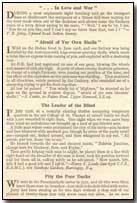Memoirs & Diaries - The Best 500 Cockney War Stories - "...In Love and War" and Other Stories
 Published in London
in 1921, The Best 500 Cockney War Stories
comprised, in the words of its newspaper publisher (The London Evening
News) "a remembering and retelling of those war days when laughter
sometimes saved men's reason".
Published in London
in 1921, The Best 500 Cockney War Stories
comprised, in the words of its newspaper publisher (The London Evening
News) "a remembering and retelling of those war days when laughter
sometimes saved men's reason".
The collection of short memoirs, some 500 in total, is divided into five categories - Action, Lull, Hospital, High Seas and Here and There. This page contains five stories from Action, led by "...In Love and War".
Other sections within the collection can be accessed using the sidebar to the right.
"...In Love and War"
During a most unpleasant night bombing raid on the transport lines at Haillecourt the occupants of a Nissen hut were waiting for the next crash when out of the darkness and silence came the Cockney voice of a lorry driver saying to his mate, "'Well,' I sez to 'er, I sez, 'You do as you like, and I can't say no fairer than that, can I?'"
F.R. Jelley, Upland Road, Sutton, Surrey
"Afraid of Yer Own Shells"
I was on the Italian front in June 1918, and our battery was being strafed by the Austrians with huge armour-piercing shells, which made a noise like an express train coming at you, and exploded with a deafening roar.
An O.K. had just registered on one of our guns, blowing the wheels and masses of rock sky-high. A party of about twenty Austrian prisoners, in charge of a single Cockney, were passing our position at the time, and the effect of the explosion on the prisoners was startling.
They scattered in all directions, vainly pursued by the Cockney, who reminded me of a sheep-dog trying to get his flock together.
At last he paused. "You windy lot o' blighters," he shouted as he spat on the ground in evident disgust, "afraid of yer own bloomin' shells!"
S. Curtis, 20 Palace Road, Upper Norwood, S.E.19
The Leader of the Blind
In July 1918, at a casualty clearing station occupying temporary quarters in the old College of St. Vincent at ruined Senlis we dealt with 7,000 wounded in eight days.
One night when we were more busy than usual an ambulance car brought up a load of gas-blinded men.
A little man whose voice proclaimed the city of his birth - arm broken and face blistered with mustard gas, though he alone of the party could see - jumped out, looked around, and then whispered in my ear, "All serene, guv'nor, leave 'em to me."
He turned towards the car and shouted inside, "Dalston junction, change here for Hackney, Bow, and Poplar."
Then gently helping each man to alight, he placed them in a line with right hand on the shoulder of the man in front, took his position forward and led them all in, calling softly as he advanced, "Slow march, left, left, I had a good job and I left it."
Henry T. Lowde (late 63rd C.C.S., R.A.M.C.), 101 Stanhope Gardens, Harringay, N.4
Pity the Poor Ducks
We were in the Passchendaele sector in 1917, and all who were there know there were no trenches - just shell-holes half-filled with water.
Jerry had been strafing us for two days without a stop and of our platoon of twenty-three men only seven came out alive. As we were coming down the duckboard track after being relieved Jerry started to put over a barrage. We had to dive for the best cover we could get.
Three of us jumped into a large shell-hole, up to our necks in water. As the shells dropped around us we kept ducking our heads under the water.
Bert Norton, one of us - a Cockney - said: "Strike, we're like the little ducks in 'Yde Park - keep going under."
After another shell had burst and we had just come up to breathe Bert chimed in again with: "Blimey, mustn't it be awful to have to get your living by ducking?"
J.A. Wood, 185 Dalston Lane, E.8
Waiting Room Only
It was in No Man's Land, and a party of New Zealand troops were making for shelter in a disabled British tank to avoid the downpour of shrapnel.
They were about to swarm into the tank when the head of a London Tommy popped out of an aperture, and he exclaimed, "Blimey. Hop it! This is a waiting room, not a blinkin' bee-hive."
A.E. Wragg, 1 Downs Road, Beckenham, Kent
Next - Not Yet Blasť and four other stories
A "Communication Trench" was a narrow trench constructed at an angle to a defensive trench to permit concealed access to the defensive trench.
- Did you know?
